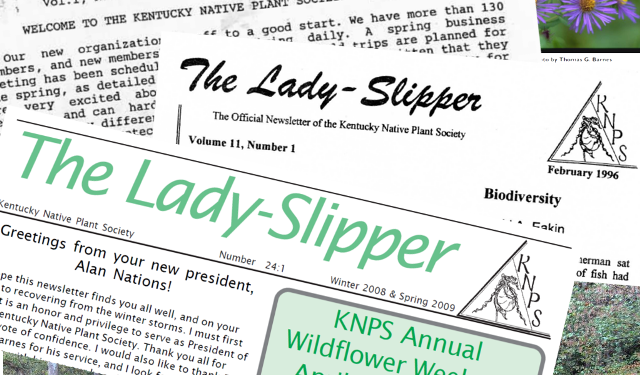
The Lady Slipper newsletter of the Kentucky Native Plant Society has been published since the Society’s founding in 1986. With this article, we will begin to occasionally feature an article from a past issue. This one, about one of Kentucky’s loveliest natives, the New England Aster, first appeared in the summer of 2010, Vol. 25, No. 2. If you would like to see other past issues, visit the Lady Slipper Archives, where all issues from Vol. 1, No. 1, February 1986 to Vol. 34, No. 1, Winter/Spring 2019 (after which we moved to this blog format) can be found.
The author, Mary Carol Cooper, left a huge legacy to the native plant community when she passed in 2016. In almost every native plant gathering, her name is mentioned and a moment is given over to appreciate her knowledge, which she freely shared. Her passion led many of us to our love of natives; she was a mentor and friend to many of us.
New England Aster: 2010 Wildflower of the Year
By Mary Carol Cooper, Salato Center Native Plant Program Coordinator
The Wildflower of the Year is chosen based on the number of nominations it receives and this year more wildflower enthusiasts statewide voted than ever before! They chose New England Aster (Symphyotrichum novae-angliae) as the Salato Native Plant Program Wildflower of the Year for 2010. Aster comes from the Greek word for “star.” It describes the star-like form of the flower. Other familiar words using “aster” are astronomy, astrology and astronaut. According to Greek legend, the aster was created out of stardust when Virgo (the maiden Astraea, goddess of innocence and purity) looking down from heaven, wept. Asters were scared to all the gods and goddesses and beautiful wreaths made from the blossoms were placed on temple altars on very important festive occasions. Known in France as “eye of Christ” and in Germany as starworts, asters were often burned to keep away evil spirits. A hodgepodge of asters was thought to cure the bite of a mad dog. Shakers used the plant to clear their complexions and ancient Greeks used it as an antidote for snakebites and to drive away snakes. Virgil believed that boiling aster leaves in wine and placing them close to a hive of bees would improve the honey. Native Americans found many uses for asters, from treating skin rashes and earaches to stomach pains and intestinal fevers. Nerve medicines and cures for insanity were made from some asters and others were eaten as food. Some were smoked in pipes as a charm to attract game, especially deer. Today there are no medical uses for asters.

The genus Aster has recently undergone a name change due to close study using DNA testing and other techniques. There are about 150 flowering plants in North America traditionally placed in the aster genus. About 50 of them are considered common and widespread. Now there is only one species left with the name Aster. The other species have been given several tongue-twisting generic names. For the botanist, renaming of the asters brought accuracy and order. For the layperson, it removed some wonderfully colorful names and replaced them with unspellable and unpronounceable names! Aster novae-angliae was translated as “star of New England” and now as Symphyotrichum novae-angliae, it is literally “fused hairs of New England.” The word Symphyotrichum was created in 1832 to describe the hairs on the seeds of a European plant.
New England Aster is an erect perennial that grows to a height of 2’ to 6’ tall with a stout root crown or thick, short rhizome and clustered stems, usually with spreading hairs. The leaves are alternate, sessile, entire, lanceolate, 1” to 4” long with pointed lobes at the base that conspicuously clasp the stem. The ray flowers range from violet, rose, or magenta and are very showy. The disk flowers are yellow. This aster is one of our largest and showiest asters. There can be from 40 to 80 ray flowers on a head! These asters bloom from August to October and are a critical late-season nectar plant for butterflies, especially the Monarch, that stock up for their long migration to Mexico. New England Asters are found in mesic to wet open woods and fields across Kentucky. They prefer average to moist soil and full sun. Not only are the New England Asters critical for Monarch butterflies, it is the host plant for the Pearl Crescent and one of the host plants for the Saddleback Caterpillar Moth. Several game birds, including the wild turkey, a few songbirds, including the tree sparrow, and small mammals, such as the chipmunk and white-footed mouse, feed on the leaves and seeds. Work plantings of New England Aster into your fall landscape. Use them singly or in small groups in the rear of a sunny border. They look beautiful with our native sunflowers, goldenrods, mistflower and rose mallow. They are also perfect for rain gardens as they thrive on moist to dry soil. They are easy to naturalize in roadside ditches, road banks, and open grassy areas. A sunny site where soil remains moist throughout the season is also ideal. Asters have always been recognized as decorations. The flowers of most species last several days after being picked and put into vases, so what better than New England Asters in beautiful fall arrangements along with other fall bloomers.
